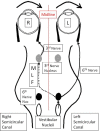Dynamic assessment of binocular eye movement coordination: norms and functional implications
- PMID: 24804278
- PMCID: PMC4010921
Dynamic assessment of binocular eye movement coordination: norms and functional implications
Abstract
Alignment of the two eyes is controlled by a finely tuned, fast acting system with components within the brain. Assessment of binocular alignment has classically been done statically. Eye positions are assessed in primary position and at eccentric angles to interpret the functional status of the oculomotor nerves and muscles. However, assessment of dynamic eye alignment, the coordination of the eyes during eye movements, has been less commonly carried out and has not been formalized with population norms. Clinicians are aware of slow eye movement dynamic alignment changes, such as that clinically observed in Intranuclear Ophthalmoplegia. But assessment of eye alignment during rapid eye movements, such as saccade or pursuit has not been part of neuro-ophthalmologic assessment. With the advent of inexpensive, high resolution recording systems, both eyes can be simultaneously recorded and their coordination during movement compared. Thus, we now have an opportunity to provide a laboratory based objective measurement of a gamut of binocular coordination systems. Recent research in humans has demonstrated increased variability of binocular coordination during divided attention. Variability is an interesting statistic that can be sensitively assessed in the velocity domain without extensive gaze position recalibration procedures during recording over long intervals. Variability can thus be used as a robust, long-term eye movement parameter with minimal intrusiveness to the subject. It is proposed that population studies of binocular coordination during eye movements be carried out to determine neurologic norms so that conditions such as brain injury and others can be assessed with a functional tool with objective parameters.
Keywords: Binocular Eye Movement Coordination; Eye Alignment; Functional Implications; Intranuclear Ophthalmoplegia.
Figures
References
-
- Tsai YF, Viirre E, Strychacz C, Chase B, Jung TP. Task performance and eye activity: predicting behavior relating to cognitive workload. Aviat Space Environ Med. 2007 May;78(5 Suppl):B176–85. PMID: 17547318. - PubMed
-
- Viirre E, Van Orden K, Wing S, Chase B, Pribe C, Taliwal V, Kwak J. Eye movements during visual and auditory task performance Society of information display. Digest of Technical Papers. 2004;35:1582–5.
-
- Bucci MP, Brémond-Gignac D, Kapoula Z. Poor binocular coordination of saccades in dyslexic children. Graefes Arch ClinExpOphthalmol. 2008 Mar;246(3):417–28. PMID: 18046570. - PubMed
-
- Gaertner C, Bucci MP, Ajrezo L, Wiener-Vacher S. Binocular coordination of saccades during reading in children with clinically assessed poor vergence capabilities. Vision Res. 2013 Jul;87:22–9. PMID: 23694682. - PubMed
-
- Bahill AT, Clark MR, Stark L. The main sequence, a tool for studying human eye movements. Mathematical Biosciences. 1975;24(3-4):191–204.
Publication types
LinkOut - more resources
Full Text Sources

